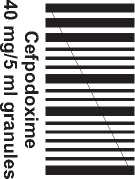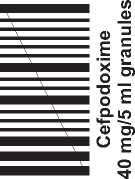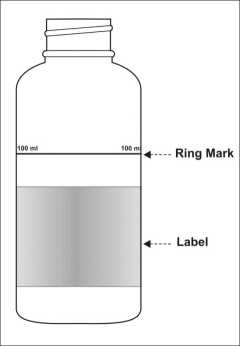Cefpodoxime 40 Mg/5 Ml Granules For Oral Suspension
Pharmacode position may change as per Supplier's m/c requirement & additional small pharma code may appear on the front / back panel
TJ
cn


LO
CL

The following table provides dosage regimen for children as per the bodyweight graduations provided on the measuring spoon:
|
Body weight in kg |
Cefpodoxime dose in mg to be used twice daily |
|
5 |
20 |
|
10 |
40 |
|
15 |
60 |
|
20 |
80 |
|
25 |
100 |
Package leaflet: Information for the user
Cefpodoxime 40 mg/5 ml granules for oral suspension
Cefpodoxime
Read all of this leaflet carefully before you start taking this medicine because it contains important information for you.
- Keep this leaflet. You may need to read it again.
- If you have any further questions, ask your doctor or pharmacist.
- This medicine has been prescribed for you only. Do not pass it on to others. It may harm them, even if their signs of illness are the same as yours.
- If you get any side effects, talk to your doctor or pharmacist. This includes any possible side effects not listed in this leaflet. See section 4.
What is in this leaflet:
1 What Cefpodoxime is and what it is used for
2 What you need to know before you take Cefpodoxime
3 How to take Cefpodoxime
4 Possible side effects
5 How to store Cefpodoxime
6 Contents of the pack and other information
1. What Cefpodoxime is and what it is used for
Cefpodoxime is an antibiotic used to kill bacteria, which cause infection in your body. It belongs to a group of antibiotics called cephalosporins.
Your doctor has prescribed Cefpodoxime because you have one (or more) of the following types of infection:
• tonsilitis
• sinusitis
• otitis media
• pneumonia
2. What you need to know before you take Cefpodoxime
• Do not take Cefpodoxime if you are allergic (hypersensitive) to cefpodoxime or other cephalosporins or any of the other ingredients of this medicine (listed in section 6).
• if you have had a severe allergic reaction to particular antibiotics (penicillins, monobactams and carbapenems) as you may also be allergic to cefpodoxime.
Tell your doctor before you start on Cefpodoxime if you think that this applies to you. You must not be given Cefpodoxime.
Warnings and precautions
Talk to your doctor or pharmacist before taking Cefpodoxime
• If you have ever been told that your kidney do not work very well. Also, if you are having any sort of treatment (like dialysis) for kidney failure. You may take cefpodoxime but you may need a lower dose.
• If you have ever had inflammation of your bowel, called colitis or any other severe disease affecting your gut.
• This medicine can alter the results of some blood tests (such as cross-matching blood and the coomb's test). It is important to tell the doctor that you are taking this medicine if you have to have any of these tests.
• This medicine can also alter the results of urine tests for sugar (such as Benedict's or Fehling's tests). If you have diabetes and routinely test your urine, tell your doctor. This is because other tests may have to be used to monitor your diabetes while you are having this medicine.
Other medicines and Cefpodoxime
Tell to your doctor or pharmacist if you are taking or have recently taken or might take any other medicines.
This medicine can be affected by other medicines that are removed by the kidneys. This is especially if these other medicines also affect how well kidneys work. There are many medicines that can do this, so should check with your doctor or pharmacist before taking this medicine.
In particular, tell your doctor or pharmacist if you are taking:
• antacids (used to treat indigestion)
• anti-ulcer agents (used to treat ulcer) such as ranitidine or cimetidine
• diuretics (used to increase urine flow)
• aminoglycoside antibiotics used to treat infections
• probenecid (used in the treatment of gout)
• anti-coagulants e.g. warfarin
Antacids and anti-ulcer treatments (such as ranitidine and cimetidine) should be taken 2-3 hours after taking Cefpodoxime. Your doctor knows about these and will alter the treatment if considered necessary.
If you require any tests (blood, urine or diagnostic), whilst taking this medicine, please ensure that your doctor knows that you are taking Cefpodoxime.
Cefpodoxime contains lactose and sucrose
Cefpodoxime contains lactose and sucrose. If you have been told by your doctor that you have an intolerance to some sugars contact your doctor before taking this medicinal product.
3. How to take Cefpodoxime
Always take Cefpodoxime exactly as your doctor has told you. Check with your doctor or pharmacist, if you are not sure.
Instructions for Reconstitution Before preparing the suspension the silica gel desiccant contained in the stopper inside the closure must be removed and disposed off. To prepare the suspension first shake the bottle to loosen granules. Add water up to about half of the 100 ml ring mark and shake vigorously.
Further add water up to the 100 ml ring mark of the bottle and shake vigorously to obtain an evenly dispersed suspension.
The recommended mean dosage for children (up to 11 years) is 8 mg/kg/day administered in two divided doses at 12-hour intervals.
The dose to be taken is indicated on the measuring spoon. The graduations correspond to the child's weight in kg from 5 kg to
25 kg with intermittent graduations of 1 kg each. The dose to be taken is read directly from the spoon. For example, if your child weighs 12kg, the spoon is filled to the 2nd graduation after 10 kg graduation mark.
The measuring spoon is only adequate for this oral suspension.
Children who weigh at least 25 kg can take 12.5 ml suspension twice daily or alternatively 100 mg film-coated tablet twice daily.
Children with kidney problems:
Depending on how serious the kidney problems are, you may need to take cefpodoxime less often, e.g. only once a day or every other day. Your doctor will decide how much you need to take.
It is important that you take your medicine at the right times of day. How to take:
It is important that you take your medicine at the right times of day. This medicine may be taken with or without food.
If you take more Cefpodoxime than you should
If you accidentally take too much medicine, contact your doctor or pharmacist who will recommend what action you should take.
If you forget to take Cefpodoxime
If you do forget to take a dose of your medicine at the correct time, you should take it as soon as possible. However, if it is almost time for your next dose, skip the missed dose. Do not take a double dose to make up for a forgotten dose. Just take the next dose at the correct time. Carry on as before.
If you stop taking Cefpodoxime
Keep taking your medicine until your doctor has told you to stop. Do not stop taking it just because you feel better. If you stop taking the medicine, your condition may reoccur or get worse.
If you have any further questions on the use of this medicine, ask your doctor or pharmacist.
6. Contents of the pack and other information
4. Possible side effects
This medicinal product is authorised in the Member States of the EEA under the following names:
|
Name of the Member State |
Name of the medicinal product |
|
Austria |
Cefpodoxim Aurobindo 40 mg/ 5 ml Granulat zur Herstellung einer Suspension zum Einnehmen |
|
France |
Cefpodoxime Arrow Generiques Enfants et Nourrissons 40 mg/ 5 ml, granules pour suspension buvable |
|
Germany |
Cefpodoxim Aurobindo 40 mg/ 5 ml Granulat zur Herstellung einer Suspension zum Einnehmen |
|
Italy |
Cefpodoxima Aurobindo 40 mg/ 5 ml granulato per sospensione orale |
|
Spain |
Cefpodoxima Aurobindo 40 mg/ 5 ml granulado para suspension oral |
|
United Kingdom |
Cefodoxime 40 mg/ 5 ml granules for oral suspension |
CL
Like all medicines, Cefpodoxime can cause side effects, although not everybody gets them. The side effects are listed by frequency.
Conditions you need to look out for
The following serious side effects have occurred in a small number of people but their exact frequency is unknown:
• severe allergic reaction. Signs include raised and itchy rash, swelling, sometimes of the face or mouth causing difficulty in breathing.
• Skin rash, which may blister, and looks like small targets
(central dark spot surrounded by a paler area, with a dark ring around the edge).
• A widespread rash with blisters and peeling skin.
(These may be signs of Stevens-Johnson syndrome or toxic epidermal necrolysis).
All of these reactions need urgent medical attention. If you think you are having any of these types of reaction, stop taking this medicine and contact your doctor or your nearest hospital accident and emergency department.
Common: (may affect up to 1 in 10 people):
• Stomach problems: Bloating, nausea, vomiting, stomach pain, flatulence (wind) and diarrhoea
• Loss of appetite
If you have severe diarrhoea or if you see blood in your diarrhoea you should stop taking this medicine and talk to your doctor immediately.
Uncommon: (may affect up to 1 in 100 people):
• Hypersensitivity reactions (These are skin rashes that are less severe allergic reactions than mentioned above, lumpy rash (hives), itching)
• Headache
• Pins and needles
• Dizziness
• Ringing in the ears
• Weakness and a feeling of generally being unwell.
Rare: (may affect up to 1 in 1,000 people):
• Changes in blood tests that check how your liver is working
• Anaemia
• Drops in the numbers of blood cells (symptoms can include tiredness, new infections and easy bruising or bleeding)
• Increase in some types of white blood cells
• Increase in the numbers of small cells that are needed for clotting of the blood.
Very rare: (may affect up to 1 in 10,000 people):
• Anaphylactic reactions (e.g. bronchospasms, purpura and edema of the face and extremities)
• Worsening in the kidney function
• Liver damage
• Having a course of cefpodoxime can temporarily increase the chance that you can get infections caused by other sorts of germs. For example, thrush may occur.
• A type of anaemia that can be severe and is caused by red blood cells breaking up.
Reporting of side effects
If you get any side effects, talk to your doctor, pharmacist or nurse.This includes any possible side effects not listed in this leaflet. You can also report side effects directly via the Yellow Card Scheme at: www.mhra.gov.uk/yellowcard.By reporting side effects you can help provide more information on the safety of this medicine.
5. How to store Cefpodoxime
Keep this medicine out of the sight and reach of children.
Do not use this medicine after the expiry date which is stated on the carton. The expiry date refers to the last day of that month.
Bottle: Store below 25°C.
Store in the original package in order to protect from light.
Reconstituted suspension: Store in a refrigerator (2°C - 8°C) for not more than 10 days.
Discard any remaining liquid after 10 days.
Do not throw away any medicines via wastewater or household waste. Ask your pharmacist how to throw away medicines you no longer use. These measures will help to protect the environment.
What Cefpodoxime contains
The active substance is cefpodoxime.
Each 5 ml of suspension contains 52.18 mg cefpodoxime proxetil (equivalent to 40 mg cefpodoxime).
• The other ingredents are lactose monohydrate, maize starch, croscarmellose sodium, ferric oxide yellow, hydroxypropyl cellulose, dispersible cellulose, silica colloidal anhydrous, citric acid anhydrous, sodium citrate, sodium benzoate, durarome flavour banana, sucrose.
What Cefpodoxime looks like and contents of the pack
Granules for oral suspension.
Off white colored granular powder forming a off white suspension with banana flavor, on constitution with water.
Cefpodoxime 40mg/5ml granules for oral suspension is available in HDPE containers of pack size of 100ml suspension.
A measuring spoon with graduations from 5 kg to 25 kg is provided with the bottle for correct dosing.
Marketing Authorization Holder
Milpharm Limited Ares, Odyssey Business Park West End Road South Ruislip HA4 6QD United Kingdom
Manufacturer
APL Swift Services (Malta) Limited HF26, Hal Far Industrial Estate, Hal Far Birzebbugia, BBG 3000 Malta
This leaflet was last revised in 01/2016.
Advice/medical education
Antibiotics are used to cure bacterial infections. They are ineffective against viral infections.
If your doctor has prescribed antibiotics, you need them precisely for your current illness.
Despite antibiotics, some bacteria may survive or grow. This phenomenon is called resistance: some antibiotic treatments become ineffective.
Misuse of antibiotics increases resistance. You may even help bacteria become resistant and therefore delay your cure or decrease antibiotic efficacy if you do not respect appropriate:
- dosage
- schedules
- duration of treatment.
Consequently, to preserve the efficacy of this drug:
1 Use antibiotics only when prescribed.
2 Strictly follow the prescription.
3 Do not re-use an antibiotic without medical prescription, even if you want to treat a similar illness.
4 Never give your antibiotic to another person; maybe it is not adapted to her/his illness.
5 After completion of treatment, return all unused drugs to your chemist's shop to ensure they will be disposed of correctly.